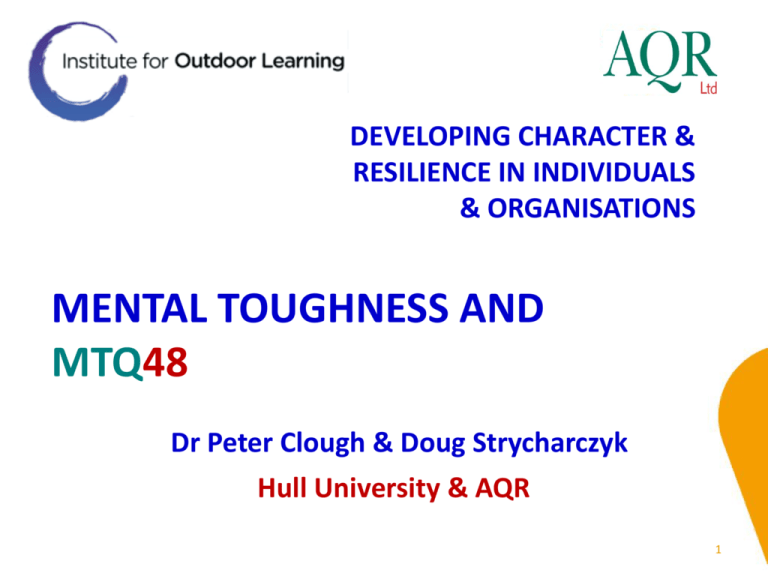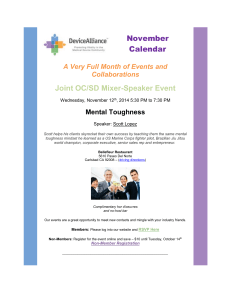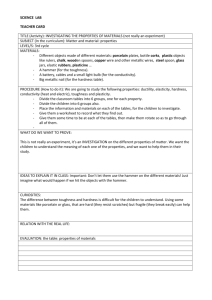Presentation title - Institute for Outdoor Learning
advertisement

DEVELOPING CHARACTER & RESILIENCE IN INDIVIDUALS & ORGANISATIONS MENTAL TOUGHNESS AND MTQ48 Dr Peter Clough & Doug Strycharczyk Hull University & AQR 1 What is MENTAL TOUGHNESS? “A personality trait which determines in large part how people deal with challenge, stressors and pressure .... irrespective of prevailing circumstances” It’s universal – it’s applicable in many walks of life. 2 Is it important? Yes! Performance – explains up to 25% of the variation in attainment Behaviour – more engaged, more positive, more “can do” Wellbeing – more contentment, better stress management , less bullying Transition – Aspirations - Retention – Employability The evidence is that Mental Toughness provides advantages but it is self awareness which is important. 3 Why is it relevant to Outdoor & Experiential Learning Mental Toughness describes a mind-set which is important for developing life skills MT can be developed – almost all effective tools and techniques are experiential. Ideally suited to this world. Understanding MT and its components enable practitioners to direct the efforts more effectively 4 Origins It has origins in the world of the academic and the practitioner. Resilience - Health psychology - Commitment, control – a passive concept Hardiness - Commitment, control + challenge – becoming proactive Dienstbier - Physiological toughening = psychological toughening Sports Psychology - MT can help lesser athletes beat more able athletes Often mentioned but poorly defined Finally Dr Peter Clough @ The University of Hull Defined MT in useful detail & added a fourth dimension – Confidence 5 The Four C’s Mental Toughness has 4 components: Challenge Control Commitment Confidence Which combine to provide an overall measure of Mental Toughness Think of these as aspects of mindset. 6 Commitment “stick-ability”. Describes to what extent you will “make promises” and the extent to which you will keep those promises. Those promises can be made to others or to themselves. When asked to do something to a target by a certain time & date do you instinctively think: I’ll go for that and I’ll do what it takes or I’ll never manage that – I’ll look stupid when I fail. 7 Commitment How do those “Low” in commitment typically behave? Will avoid setting goals and targets –failure will expose them as “failures” Exams, tests, assignments are threatening Goals & targets are intimidating to them Give up easily and find a reason for it Will try to ignore goals and targets Distract attention from the goal – “ I would have done it but I did this other thing/ was asked to do something else, etc” Often respond to the last person to ask them to do something 8 Commitment How do those “High” in commitment typically behave? Will translate goals and targets into “pictures of success” & plan for attainment. Exams, tests, assignments are welcomed Set targets for themselves - pbs Work hard and go for it. Excited by measures, goals and targets 9 Commitment Are there “downsides” for those “High” in commitment? Are there “upsides” for those who aren’t “High” in commitment? 10 Control “Can do”. Describes to what extent you believe you shape what happen to you and manage your emotions when doing it. There are two components : Life-Control Emotional Control When asked to do something , is your default response: I can do it …. without needing to check if it is possible I’ll stay in control of my emotions 11 Life Control How do those “Low” in life control typically behave? They are fatalists – things happen to them Do one thing at a time – panic when overloaded Blame others and circumstances for failures Tend to focus on why things cant be done Cup half empty 12 Life Control How do those “High” in life control typically behave? Believe they make difference Happily multi-task Good at planning & organisation Will try to ignore goals and targets Cup is half-full. Everything is possible. Work hard to clear blockages Problems exist – they are there to be handled 13 Life Control Are there “downsides” for those “High” in “Life Control”? Are there “upsides” for those who aren’t “High” in “Life Control”? 14 Emotional Control How do those “Low” in emotional control typically behave? Reveal their emotional state to others Deal poorly with criticism or negative feedback Feel things happen to them Get down when things go wrong Can lose it when provoked or annoyed. 15 Emotional Control How do those “High” in emotional control typically behave? Manage their emotional response to situations Difficult to provoke or annoy Deal well with difficult people Mask anxiety – maintain poise Deal well with bullying behaviour 16 Emotional Control Are there “downsides” for those “High” in “Emotional Control”? Are there “upsides” for those who aren’t “High” in “Emotional Control”? 17 Challenge “drive”. Describes to what extent you challenges, change, adversity & variety as opportunities or as threats. When asked to do something significant or challenging is your immediate response to say: That’s great – I look forward to whatever emerges or Oh no! I like things the way they are – I'm frightened by what might happen. 18 Challenge How do those “Low” in challenge typically behave? Hate change and variety of any sort. Don’t like shocks & surprises Hate new places; people; subjects, bosses, etc Respond poorly to competitive types Risk averse Avoid effort and anything which attracts attention 19 Challenge How do those “High” in challenge typically behave? Like challenge Easily bored – will seek change - may provoke change Like problem solving Work hard & smart Risk orientated Readily volunteer 20 Challenge Are there “downsides” for those “High” in challenge? Are there “upsides” for those who aren’t “High” in challenge? 21 Confidence “Self Belief”. Describes to what extent you believe you have the ability to deal with what will face you and the inner strength to stand your ground when needed. There are two components : Confidence in Abilities Interpersonal Confidence When doing something and you face a problem, is your default response: I have the capability to plough on? I’ll deal with those who get in my way? 22 Confidence in Abilities How do those who have “Low” confidence in abilities typically behave? Will be reluctant to express a view in discussion or debate Low self belief. Not confident that they know subject matter even they you do. Inner belief missing – need others to build that. Unsure whether they have grasped a subject or not – feel they are still missing something 23 Confidence in Abilities How do those who have “High” confidence in abilities typically behave? Don't need others to tell them they can do it or to encourage them. Happily to engage in discussion even if it takes them into the unknown Can believe they are right .. Even when they are wrong Little or no need for external validation. 24 Confidence in Abilities Are there “downsides” for those with “High” confidence in abilities? Are there “upsides” for those who don’t have “High” confidence in abilities? 25 Interpersonal Confidence How do those “Low” in interpersonal confidence typically behave? Back down quickly when challenged Will allow others to dominate debates – even when they are more knowledgeable and more expert Will have difficulty dealing with assertive people Wont ask questions in group settings Will accept criticism even when its not deserved 26 Interpersonal Confidence How do those “High” in interpersonal confidence typically behave? Will argue their corner – especially if they believe they are right Will gets their own way – even when others may have a better case Wont allow others to orally dominate Will have a “go” and enter a conversation. Will often provide a full response to questions 27 Interpersonal Confidence Are there “downsides” for those “High” in Interpersonal confidence Are there “upsides” for those “High” in Interpersonal confidence 28 The Four C’s – a summary Control Commitment Challenge Confidence - I really believe I can do it - I can keep my emotions in check when doing it - I promise to do it and will set goals - I will do what it takes - I am motivated to do it – I can see the opportunity - I believe I have the ability to do it - I can argue my corner if I need to Together these give rise to Mental Toughness 29 THE MODEL – its fit with current thinking Introduces the ideas of Fixed Mindset Flexible Mindset Introduces the ideas of Talent Myth Purposeful practice Introduces the ideas of Learned Helplessness Learned Optimism & Happiness 30 THE MODEL –current thinking One interesting observation is that all models have, as a core concept, the requirement to work hard as well as work smart. There is a recognition that the West might have a technological advantage but the third world is catching up quickly but is doing this with a better work ethic. “Success is 99% perspiration and 1% inspiration” Benjamin Franklin 31 The next level of validation of the MTQ48 University of Western Ontario – examining mono-zygotic and Dizygotic twins University of Basle – examining adolescent behaviour – dealing with anxiety, sleep. Etc University of Lincoln –relationship with emotional intelligence Universities of Parma & Modena & Reggio – Brain Scan studies providing a biological explanation & ongoing studies in the Gulf, US, Australia and , of course, Hull. 32 Side view 33 Measuring Mental Toughness MTQ48 Questionnaire 3 versions: 1. Occupational (all ages) 2. Young persons (age 11- 17) 3. on its way –early years (age 3- 5) and junior school (age 7 – 10) Normative, valid and reliable measure On-line format (can print off questionnaires) Easy to use On-line facility also helps to manage data Short inexpensive licensed user training (2 days) 34 Mental Toughness Development The Mental Toughness model is a fairly complete process Understanding – the model provides a structure around which to assess an important requirement for performance and wellbeing. Diagnosis – the measure enables diagnosis, assessment and measurement at a useful level – the 4Cs What are my issues? What are their implications? What will I seek to develop/improve? Where is it best to start? Interventions – ability to direct interventions better and to select appropriate interventions –works with any intervention strategies. Evaluation – the ability to measure change and to relate it to action. 35 Mental Toughness Development Interventions fall into 6 broad areas: 1 Positive thinking – affirmations, think three positives, turning negatives into positives, etc 2 Visualisation – guided imaging, using your head to practice, etc 3 Anxiety Control – relaxation techniques, breathing, etc 4 Attentional Control – focus, dealing with interruptions 5 Goal setting – SMART, balancing goals, how to deal with big goals, etc 6 The test itself + feedback – people respond to the feedback Plus Biofeedback – monitoring self, guiding selection and adoption of tools and techniques These all help to develop the capability to deal with stress, pressure and challenge and, where appropriate, to cope with these. 36 Mental Toughness Development - Positive Thinking The underlying principle - we are what we think. affirmations, think three positives, turning negatives into positives, self talk thought stopping looking at role models what will I do tomorrow? attitude ladder 37 Mental Toughness Development - Visualisation The underlying principle - We can imagine success or we can imagine failure and we can learn from that. guided imagery pink elephant change your environment target practice penalty shoot out 38 Mental Toughness Development - Anxiety Control The underlying principle Psychological responses such as fear & worry have a physiological consequence Controlling those physiological response can help us to manage the mental responses. control distraction controlled breathing muscular relaxation ear tap smiling and laughing self hypnosis sleep anchoring 39 Mental Toughness Development - Goal Setting The underlying principle Give meaning and direction as well as fuel and energy to achieve objectives & approach new challenges. smart goals balancing goals setting milestones 40 Mental Toughness Development - Attentional Control The underlying principle Focus, sustained attention and concentration, enables us to work better and for longer Interruptions and distractions undermine that capability minimising interruptions concentration stork stand shut out distractions 41 Mental Toughness Development Thank You We’re around if you have any questions 42 Visualisation seeing success http://www.youtube.com/watch?v=7n6NhV4CaiU 43 Performance Perform better in exams ands tests Produce better coursework Achieve more – cover more subjects Work harder Competitive Studies show that up to 25% of the variation in an individuals performance on tests can be explained by their mental toughness 44 Behaviour More positive – “can do” More likely to respond positively to change More likely to engage – will volunteer for activities More likely to accept responsibility Better disciplined - attendance 45 Wellbeing Deal better with stress and pressure Sleep better! Less likely to develop mental health issues Can relax even after the most challenging time Report much less bullying behaviour Less likely to consciously adopt bullying behaviour 46 Aspirations & Employability More ambitious Set higher standards More confident Adopt a competitive approach Deal better with redundancy More likely to get a job 47 Transition Deal better with New schools New courses New tutors New experinces 48 Completion on Time and on Target More stick-ability – will complete programmes Better at project management Take setbacks and change in their stride. 49







